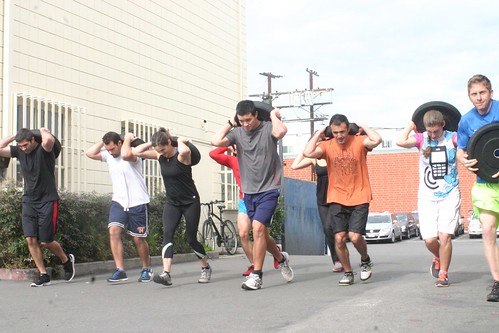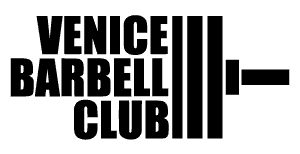No Sugar Coating This
Friday, March 1, 2013
EIE Challenge Tip of the Day 5: Keep your camera or phone on you today and photograph all your meals and snacks prior to eating! Create a photo food diary for the day. This one step alone will make you more aware and accountable of your food choices. It’s also a perfect tool to show your coaches if you want to discuss your diet and make sure you are on the right track!
Mobility:
T-Spine Smash
Hip Extension with band
Posterior Chain Flossing with Band
Internal Rotation Stretch on Bar
Internal Rotation Smash with barbell
Group Warmup:
with empty barbell:
5 Pause Back Squats
10 Deadlifts
5 Hang Squat Cleans
5 Pendlay Rows
5 Push Press
Classic Programming
Strength:
5X2 Deadlift
Notes: These are NOT touch and go reps. Work on controlling the lowering of the bar if possible and reset momentarily at the bottom before performing the second rep.
Conditioning:
15 min AMRAP:
10 Kettlebell Swings 32/24kg
10 Wall Balls
5 Pull-ups
200 meter row
Advanced Programming
Strength:
5X2 Top Pull Deadlifts @ 90% – rest 60 sec. DEMO
Conditioning:
30 Kettlebell swings 32/24kg
30 Wall Balls 20/14#
30 Chest to bar Pull-ups
Row 1000 meters
20 KBS 32/24kg
20 Wall Balls 20/14#
20 C2B Pull-ups
*20 min time cap.
Notes: If you cannot perform more than at least three unbroken C2B pull-ups scale to regular pull-ups
Cool down:
German Stretch
Pigeon Stretch
Couch Stretch (aka Quad on the Wall)
Straddle Stretch
Below is my straight to the point FAQ section on all things Sugar. For me personally, my will power and control over my diet are directly correlated to the amount of research I have done and recently reviewed on the subject. I have several videos that I can watch any time I am feeling doubtful, discouraged, or embarrassed about my diet that get me completely fired up and remind my why I’m doing this stuff in the first place: my health!. Hopefully the below information and tools will do the same for you to stay committed to your journey.
Why is Sugar bad?
Once dissolved in water, sugar can bind and stick to other mobile proteins in a process called glycation. With enough heat or time, these bonds can oxidize and become permanent forming advanced glycation end products, or AGEs. The acronym is appropriate, because AGEs make you age extremely fast. An easy way to see this is when you toast a piece of bread. The heat prompts oxidation reactions between the sugars and proteins that generate AGEs which we see as a hard, stiff, crispy, burnt outside. The same thing can happen in our bodies and our blood stream. That is why elevated blood sugar is so bad, because it can make our cells brittle and stiff and cause a host of problems. Fortunately, at normal blood sugar levels, this process is so slow that white blood cells can break them down and take care of the mess before it ever gets out of hand.
What’s the connection between Sugar and Insulin?
One of the biggest reasons to avoid sugar is it completely messes with your hormones. When you eat any carbohydrate your body breaks it down to sugar and pushes it to your blood stream. With the sudden rise in blood sugar, the alarms go off because elevated levels are bad (see AGEs above), and your pancreas releases just a little bit of insulin. Insulin is a sugar wrangler whose job is to sweep it out of the blood stream and keep blood sugar at a normal level. So Insulin deposits sugar into the muscles, levels normalize, and it can now go home after a hard day’s work. Blood sugar is normal, insulin levels are normal, and your muscles have stored energy ready to go. That is normal metabolism at work.
However, if you eat a low fat, high carbohydrate diet all the time then your blood sugar is through the roof! You pancreas is screaming, “Emergency!” and pumping out a ton of insulin because all this sugar is extremely toxic. The insulin pushes it to the muscles like normal but at a certain point the muscles reach capacity and the bouncer at the door doesn’t let anyone else in. Now insulin doesn’t know what to do so it goes down the street to shadier club, the fat cells, and the bouncer there says, “Come right in! No cover charge or ID!” They fill up quick and now you have abdominal obesity and inflammation and a ton of other problems. Usually this situation continues and before long then even the fat cells reach capacity and close the doors, and now there is nowhere for the blood sugar to go, and that’s when you are left with Type 2 Diabetes, heart disease, metabolic syndrome, and all the other effects of high blood sugar, high insulin, and AGEs.
What are the effects of Sugar on my body?
According to Mark’s Daily Apple, sugar has the following deleterious effects on your body:
- Sugar stimulates a physiological stressor-reaction cascade that provokes adrenaline and cortisol release and thickens the blood.
- Sugar effectively disables your immune system by impairing white blood cells’ functioning.
- Sugar decreases your body’s production of leptin, a hormone critical for appetite regulation.
- Sugar induces significant oxidative stress in the body.
- Sugar appears to fuel cancer cells.
- Sugar promotes fat storage and weight gain.
- Sugar disrupts the effective transfer of amino acids to muscle tissue.
- Sugar intake over time spurs insulin resistance, subsequent Type II diabetes and the entire host of related health issues like nerve damage and cardiovascular disease.
Dr. Cate Shanahan has a similar list of the effects of elevated blood sugar on the cells of your body. According to her book, Deep Nutrition, sugar can impair the immune system by curbing the function of white blood cells, impair the circulatory system by curbing the function of red blood cells, cause birth defects, Type II Diabetes, seizures and chronic headaches, heart palpitations, increase LDL cholesterol, and even damage brain cells making it harder to learn and eventually contribute to dementia!
What counts as a Sugar?
The problem with sugar is that it has so many different names and forms, and is tucked conveniently into almost all processed foods. When something is low-fat, it tends to taste pretty bad, so the food manufacturers need to pack in a bunch of sugar in order to make it appetizing.
Sugar’s Pseudonyms
Evaporated Can Juice, Corn Syrup, Corn Sweeteners, High-Fructose Corn Syrup, Crystalline Fructose, Fructose, Sucrose, Malt, Malt Syrup, Barley Malt Syrup, Barley Malt Extract, Maltose, Maltodextrin, Dextrose, Maple Syrup, Brown Rice Syrup, Beet Juice, Muscovato, Succanat, Turbinado Sugar, Invert Sugar, Honey.
Another form of sugar is often overlooked or ignored because it doesn’t taste sweet; carbs. Unfortunately, as far as your body is concerned, carbohydrates are sugar! It doesn’t matter if the bread and rice are white or brown, or the carbs are simple or complex, they all get broken down to the same thing and absorbed the same way. For example, seven ounces of cooked spaghetti is converted into the same amount of sugar present in four 12-ounce cans of Pepsi! You can also test this by letting a piece of bread sit in your mouth. The saliva breaks the starch down into smaller sugar molecules and it starts to taste sweet.
Fruit contains fructose, and is not recommended for weight loss. See the video Sugar: The Bitter Truth, below, for more information on fructose and how it is processed by your liver.
How much Sugar is in processed food and drinks?
Head over to www.sugarstacks.com to check it out for yourself! At both gyms there will be common beverages filled with the amount of sugar they contain. It might gross you out and make you think twice about that vending machine!
What about natural sweeteners and artificial sweeteners?
I’m going to let Shauna Young in her book about Naturopaths take this one away: “Most people have heard that artificial sweeteners are a problem, but in my mind few are taking the dangers of them seriously enough. People forget that the original artificial sweeteners were released onto the market as ant poisons (they work very well for that by the way), and they are serious and potentially deadly neurotoxins. It was only after it was discovered that they were so sweet and calorie-free that they were declassified as “poison” and reclassified as a “dietary ingredient”.”
Another way I have heard this simply put is that artificial sweeteners don’t exist anywhere on this planet and are therefore an alien substance in our bodies. They are created in laboratories and not something you should be putting in your body, ever!
The healthiest natural sweetener to use is Stevia (Sweet Leaf and Stevita being the best brands, one of which is carried at Rainbow Acres!), a natural herb.
The worst natural sweeteners to use are High-Fructose Corn Syrup and Agave Nectar, because of their high fructose content. HFCS contains 55% fructose, while Agave Nectar can range between 55-90% depending on the brand, making it much worse for you actually. What’s crazy is that marketing has touted it as a healthy sweetener and is present in almost every cocktail menus because it sounds so exotic.
Why is Sugar so addicting?
As humans we crave three tastes (sugar, salts, and fat) and there was an important reason for all three of the cravings in the history of our survival as a species. Humans don’t produce vitamin C, and the sweetest fruits contain the most vitamin C, so it was very important for our species to generate a reward system (think “sweet tooth”) that promoted seeking and eating these types of foods as much as possible. But now that there is unlimited access to sugar that reward system has gone out of control.
A key element in this natural reward system is dopamine. Dopamine is released any time you get excited about something to which you have a positive association, like food, sex, sleep, drugs, Christmas, Crossfit, whatever.
This feeling of excitement and enjoyment is what makes saying no practically impossible, even if you muster up all of your will power. To combat this tendency, you have to reverse the positive associations you may have with bad foods. If you believe that sugar is bad for you, will not support your lifestyle or your long term health goals, then bad foods will have smaller chemical and emotional effect on your brain and will power. Cocaine is addicting because it increases the amount of dopamine in your brain.
When you taste something sweet, your body also releases its own endogenous opiates that trigger the pleasure centers of the brain. Heroine actually contains opiates and is addicting through the same mechanism. Endorphins are examples of our natural endogenous opiates that act as a pain reliever similar to morphine. This is the runners high so many people are addicted to and why exercise is important to release stress and fight off cravings!
What supplements can I take to fight cravings?
The short answer is Glutamine, but I have not had a chance to research this or test this out.
I will leave you with a quote from Julia Ross in her book, The Diet Cure, and you can do your own research and make your own decision:
“It may sound impossible, but you might be able to stop your food cravings almost instantly with just one amino acid supplement. Any absence of fuel for your brain’s functions is perceived correctly by your body as a code-red emergency. Powerful biochemical messages then order you to immediately eat refined carbohydrates to quickly refuel your brain. There are only two fuels that the brain can readily use:
1. Glucose, which is blood sugar made instantly from sweets or starches (fats and proteins can also be broken down to make glucose slowly and steadily)
2. Glutamine, an amino acid protein made from foods (and available as a supplement carried in all health food stores)
Glutamine reaches the starving brain within minutes and can often immediately put a stop to even the most powerful sweet and starch cravings. The brain is fueled by glutamine when glucose levels drop too low. Don’t be intimidated by the strong effects of supplementation. Glutamine is a natural food substance; in fact, it’s the most abundant amino acid in our bodies. It serves many critical purposes: stabilizing our mental functioning, keeping us calm yet alert, and promoting good digestion.“
Additional Resources
Sugar: The Bitter Truth. This is a 1 hour and 30 minute lecture on youtube about the effects of sugar on our bodies. If you have the patience and the nerdiness, this is a must watch. It currently has over 3 million views. Every time I watch it I abstain from sugar for at least a week, and any time I do eat sugar, this video is always in the back of my mind.
http://endsugaraddiction.com and www.addictionsunplugged.com are two places to start for more information if you feel you have a sugar addiction that you can’t quit.
Sources
Unleashing Your Thin with Jonny Bowden, Underground Wellness Podcast
Deep Nutrition, by Catherine Shanahan
The Definitive Guide to Sugar, Mark’s Daily Apple
If Naturopaths Are “Quacks”… Then I Guess I’m Duck, by Shauna Young
The Historical Truth about Raw Fruit Consumption, presentation by David Getoff at Real Food Summit
The Diet Cure, by Julia Ross
















